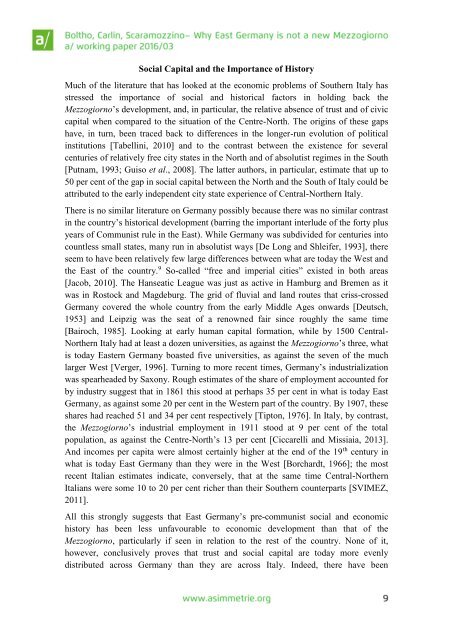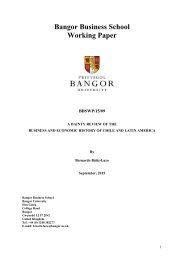n?u=RePEc:ais:wpaper:1603&r=his
n?u=RePEc:ais:wpaper:1603&r=his
n?u=RePEc:ais:wpaper:1603&r=his
Create successful ePaper yourself
Turn your PDF publications into a flip-book with our unique Google optimized e-Paper software.
Social Capital and the Importance of History<br />
Much of the literature that has looked at the economic problems of Southern Italy has<br />
stressed the importance of social and historical factors in holding back the<br />
Mezzogiorno’s development, and, in particular, the relative absence of trust and of civic<br />
capital when compared to the situation of the Centre-North. The origins of these gaps<br />
have, in turn, been traced back to differences in the longer-run evolution of political<br />
institutions [Tabellini, 2010] and to the contrast between the existence for several<br />
centuries of relatively free city states in the North and of absolutist regimes in the South<br />
[Putnam, 1993; Guiso et al., 2008]. The latter authors, in particular, estimate that up to<br />
50 per cent of the gap in social capital between the North and the South of Italy could be<br />
attributed to the early independent city state experience of Central-Northern Italy.<br />
There is no similar literature on Germany possibly because there was no similar contrast<br />
in the country’s historical development (barring the important interlude of the forty plus<br />
years of Communist rule in the East). While Germany was subdivided for centuries into<br />
countless small states, many run in absolutist ways [De Long and Shleifer, 1993], there<br />
seem to have been relatively few large differences between what are today the West and<br />
the East of the country. 9 So-called “free and imperial cities” existed in both areas<br />
[Jacob, 2010]. The Hanseatic League was just as active in Hamburg and Bremen as it<br />
was in Rostock and Magdeburg. The grid of fluvial and land routes that criss-crossed<br />
Germany covered the whole country from the early Middle Ages onwards [Deutsch,<br />
1953] and Leipzig was the seat of a renowned fair since roughly the same time<br />
[Bairoch, 1985]. Looking at early human capital formation, while by 1500 Central-<br />
Northern Italy had at least a dozen universities, as against the Mezzogiorno’s three, what<br />
is today Eastern Germany boasted five universities, as against the seven of the much<br />
larger West [Verger, 1996]. Turning to more recent times, Germany’s industrialization<br />
was spearheaded by Saxony. Rough estimates of the share of employment accounted for<br />
by industry suggest that in 1861 this stood at perhaps 35 per cent in what is today East<br />
Germany, as against some 20 per cent in the Western part of the country. By 1907, these<br />
shares had reached 51 and 34 per cent respectively [Tipton, 1976]. In Italy, by contrast,<br />
the Mezzogiorno’s industrial employment in 1911 stood at 9 per cent of the total<br />
population, as against the Centre-North’s 13 per cent [Ciccarelli and Missiaia, 2013].<br />
And incomes per capita were almost certainly higher at the end of the 19 th century in<br />
what is today East Germany than they were in the West [Borchardt, 1966]; the most<br />
recent Italian estimates indicate, conversely, that at the same time Central-Northern<br />
Italians were some 10 to 20 per cent richer than their Southern counterparts [SVIMEZ,<br />
2011].<br />
All this strongly suggests that East Germany’s pre-communist social and economic<br />
history has been less unfavourable to economic development than that of the<br />
Mezzogiorno, particularly if seen in relation to the rest of the country. None of it,<br />
however, conclusively proves that trust and social capital are today more evenly<br />
distributed across Germany than they are across Italy. Indeed, there have been






